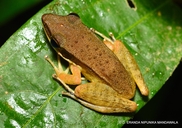|
Description
Indosylvirana serendipi is a small-sized frog with snout vent length of 36.9 mm in males. Head small (HW 11.5, HL 14.8, IFE 6.3, IBE 9.3), longer than wide, flat above; snout sub-elliptical in dorsal and ventral view, rounded in lateral view, protruding, its length (SL 6.7) longer than horizontal diameter of eye (EL 4.9); loreal region acute and concave with rounded canthus rostralis; interorbital space flat, equal (IUE 3.2) to upper eyelid (UEW 3.2) and subequal to internarial distance (IN 3.6); distance between back of eye (IBE 9.3) 1.5 times the distance between front of eye (IFE 6.3); nostril oval, closer to tip of snout (NS 2.0) than eye (EN 4.2); tympanum (TYD 3.5) 71% of eye diameter (EL 4.9); tympanum-eye distance (TYE 0.8); pineal ocellus present, between anterior border of eye; vomerine ridge present, bearing small teeth, with an angle of 40° to body axis, as close to choanae as to each other; tongue moderately large, emarginated. Forelimbs moderately short and thin; forelimb (FAL 7.1) shorter than hand length (HAL 11.1), finger length formula ISkin of snout, between eyes, side of head and anterior part of dorsum granular, more prominently granular on upper eyelids; posterior part of back and upper part of flanks granular; lower part of flanks rather smooth; dorsolateral folds that extend from the posterior corner of the eye to the entire body length on both sides, moderately developed; dorsal part of forelimb smooth, thigh, tibia and tarsus with glandular warts in longitudinal lines bearing horny spinules; distinct rictal gland posterior to corner of mouth; flat indistinct humeral glands; ventral part of throat smooth, anterior part of belly shagreened, posterior part of belly and thigh shagreened (Biju et al. 2014).
Colour in life: Dorsum uniform reddish-brown with black specks; tympanum and surrounding area dark brown; upper lip with white stripe continuing through yellowish-white rictal gland to above arm insertion; iris reddishbrown with golden specks and dark patches on either side; flanks light yellowish-grey; limbs dorsally light brown with light grey cross-bands; ventral side white, throat and limbs light grey, feet and webbing dark grey (Biju et al. 2014).
Colour in alcohol: Dorsum light brown in colour; lower flanks dark grey with black speckles; tympanic area dark grey; upper lip with white stripe continuing through rictal gland to above arm insertion; dorsolateral folds light brown; forelimbs, dorsal parts of thigh, tibia and foot light brown coloured; throat and margin of throat greyish-white; chest and belly greyish-white; ventral parts of thigh, tibia and foot light brownish-white; webbing dark grey with minute specks (Biju et al. 2014).
Distribution and Habitat
Country distribution from AmphibiaWeb's database: Sri Lanka
Indosylvirana serendipi is found in lowland wet zone of Sri Lanka (Biju et al.,2014; Oliver et al.,2015; Batuwita et al. 2019).Life History, Abundance, Activity, and Special Behaviors
This species is found on the banks of streams and in marshy areas, which were under forest cover, where it was relatively abundant during the breeding season (May-August). These marshy areas are covered with a thick layer of leaf litter (Biju et al. 2014). Comments
Etymology: Indosylvirana serendipi is named after an ancient name for Sri Lanka. The English word serendipity, for which the contemporary meaning is ‘a fortunate discovery or an event by chance’, has its earliest roots in Sanskrit, where Sri Lanka was referred to as Swavarnadveepa, and later modified by Persian merchants as Serendip (Biju et al. 2014).
I. serendipi is closely related to I. temporalis from which it differs by an average genetic divergence of 10.5 ± 0.1% for 16S, 18.1 ± 0.2% for COI and 23.8 ± 0.6% for Cytb. I. serendipi was long misidentified as I. aurantiaca from India (Biju et al. 2014).
References
Batuwita S, Udugampala S, DeSilva M, Diao J and Edirisinghe U. (2019). "A review of amphibian fauna of Sri Lanka: distribution, recent taxonomic changes and conservation." Journal of Animal Diversity, 1(2), 44-82. [link]
Biju, S.D., Garg, S., Mahony, S., Wijayathilaka, N., Senevirathne, G., Meegaskumbura, M. (2014). ''DNA barcoding, phylogeny and systematics of Golden-backed frogs (Hylarana, Ranidae) of the Western Ghats-Sri Lanka biodiversity hotspot, with the description of seven new species.'' Contributions to Zoology, 83(4), 269-335. [link]
Oliver, L.A., Prendini, E., Kraus, F., and Raxworthy, C.J. (2015). ''Systematics and biogeography of the Hylarana frog (Anura: Ranidae) radiation across tropical Australasia, Southeast Asia, and Africa.'' Molecular Phylogenetics and Evolution, 90, 176-192.
Originally submitted by: Dayupathi Eranda Nipunika Mandawala (2021-03-24)
Edited by: Michelle S. Koo (2021-05-09)Species Account Citation: AmphibiaWeb 2021 Indosylvirana serendipi: Sri Lankan Golden-backed frog <https://amphibiaweb.org/species/8253> University of California, Berkeley, CA, USA. Accessed Apr 18, 2024.
Feedback or comments about this page.
Citation: AmphibiaWeb. 2024. <https://amphibiaweb.org> University of California, Berkeley, CA, USA. Accessed 18 Apr 2024.
AmphibiaWeb's policy on data use.
|




 Map of Life
Map of Life